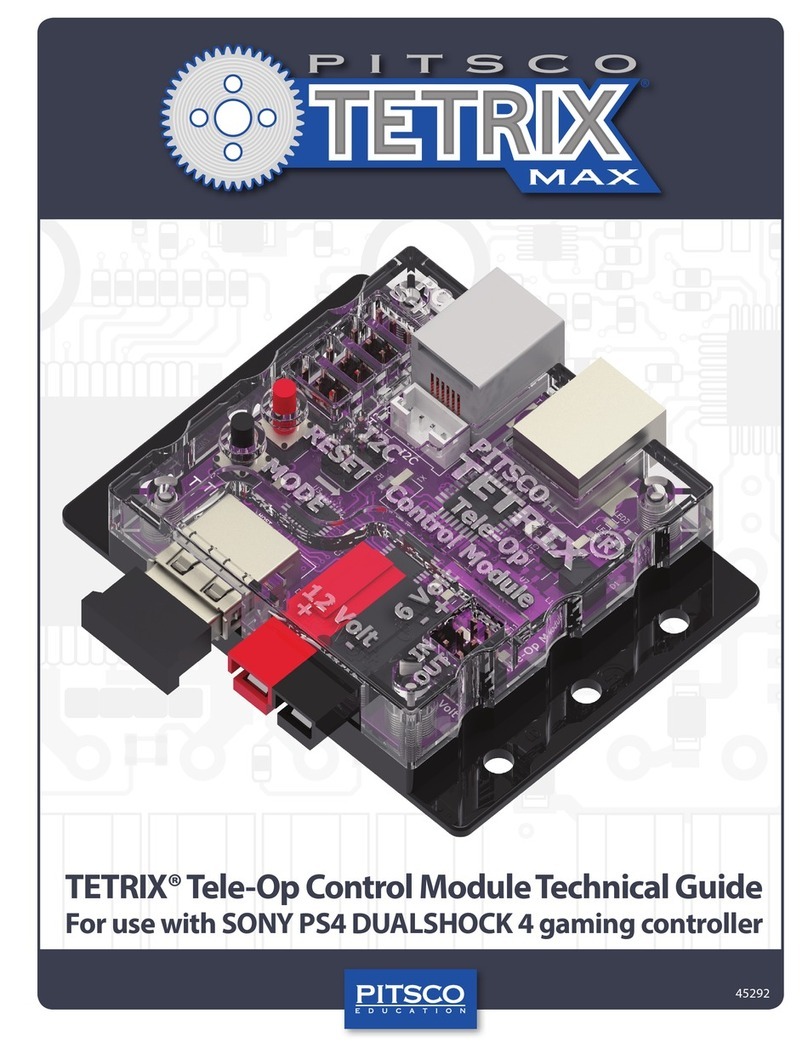
TETRIX Set Motor Speed(s)
Simultaneously sets the constant speed parameter for each DC motor channel. This VI uses motor encoders to implement
constant-speed PID control.
• myRIO MXP Port A/B – the myRIO MXP port to which the adapter board is connected
• Error/Flow In – program execution flow in from previous VI block
• Error/Flow Out – program execution flow out to next VI block
• Controller ID# – This is the ID#/i2C address of the expansion controller. Valid range is 1-120; however, 5 and 6 are
reserved and cannot be used. The default ID# for the DC motor expansion controller is 1.
• Motor 1 Speed – This sets the constant speed parameter for motor channel 1. The constant speed parameter is set
in degrees per second. The maximum speed that can be set depends on the type of rpm and gearing of the motor.
For best constant-speed PID performance, a maximum speed setting of about 75% of the full motor rpm rating is
recommended. For the TETRIX TorqueNADO motor, the maximum constant speed parameter is approximately 450
degrees per second.
• Motor 2 Speed – This sets the constant speed parameter for motor channel 2. The constant speed parameter is set
in degrees per second. The maximum speed that can be set depends on the type of rpm and gearing of the motor.
For best constant speed PID performance, a maximum speed setting of about 75% of the full motor rpm rating is
recommended. For the TETRIX TorqueNADO motor, the maximum constant speed parameter is approximately 450
degrees per second.
TETRIX Set Motor Target
Sets the constant speed and encoder target parameters for the selected DC motor channel. This VI uses the motor encoder
to implement constant velocity and position hold control.
• myRIO MXP Port A/B – the myRIO MXP port to which the adapter board is connected
• Error/Flow In – program execution flow in from previous VI block
• Error/Flow Out – program execution flow out to next VI block
• Controller ID# – This is the ID#/i2C address of the expansion controller. Valid range is 1-120; however, 5 and 6 are
reserved and cannot be used. The default ID# for the DC motor expansion controller is 1.
• Select Channel – This selects Motor 1 or Motor 2.
• Encoder Units – This sets the target units as either degrees or encoder counts. For the TETRIX TorqueNADO motor
encoder, 1 encoder count is equal to 1/4 degree. When using encoder counts, 1,440 counts equal 360 degrees, or
one full motor shaft revolution.
• Constant Speed – This sets the constant speed parameter for the selected channel while it is moving to the encoder
target. The constant speed parameter is set in degrees per second. The maximum speed that can be set depends
on the rpm of the motor being controlled. For best constant-speed PID performance, a maximum speed setting of
about 75% of the full motor rpm rating is recommended. For the TETRIX TorqueNADO motor, the maximum constant
speed parameter is approximately 450 degrees per second.
• Motor Encoder Target – This sets the targeting parameter for the DC motor channel. Depending on the encoder
units selected, this parameter can be expressed in degrees or encoder counts.
TETRIX Set Motor Speed(s)
[TETRIX_Set_Motor_Speed(s)_myRIO.vi]
myRIO MXP Port A/B
Error/Flow In
Controller ID# (i2C Address)
Motor 1 Speed (Degrees per...
Motor 2 Speed (Degrees per...
Error/Flow Out
TETRIX Set Motor Target
[TETRIX_Set_Motor_Target_myRIO.vi]
Constant Speed (Degrees per...
myRIO MXP Port A/B
Error/Flow In
Controller ID# (i2C Address)
Select Channel
Encoder Units
Motor Encoder Target
Error/Flow Out




























